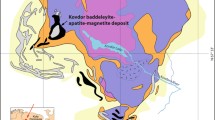Abstract
A probabilistic neural network is employed to classify 1610 mineral deposits into 18 types using tonnage, average Cu, Mo, Ag, Au, Zn, and Pb grades, and six generalized rock types. The purpose is to examine whether neural networks might serve for integrating geoscience information available in large mineral databases to classify sites by deposit type. Successful classifications of 805 deposits not used in training—87% with grouped porphyry copper deposits—and the nature of misclassifications demonstrate the power of probabilistic neural networks and the value of quantitative mineral-deposit models. The results also suggest that neural networks can classify deposits as well as experienced economic geologists.
Similar content being viewed by others
References
Barton, P. B., 1986, Mineralogical index, in Cox, D. P., and Singer, D. A., eds., Mineral deposit models: U.S. Geological Survey Bulletin 1693, p. 318–348.
Bliss, J. D., ed., 1992, Developments in mineral deposit modeling: U. S. Geological Survey Bulletin 2004, 168 p.
Cox, D. P., and Singer, D. A., eds., 1986, Mineral deposit models: U.S. Geological Survey Bulletin 1693, 379 p.
Cox, D. P., Lindsey, D. A., Singer, D. A., and Diggles, M. F., 2003, Sediment-hosted copper deposits of the world—Deposit models and database: U.S. Geological Survey Open-File Report 03-107, http://geopubs.wr.usgs.gov/open-file/of03-107/.
McCammon, R. B., 1992, Numerical mineral deposit models, in Bliss, J. D., ed., Developments in deposit modeling: U.S. Geological Survey Bulletin 2004, p. 6–12.
Masters, T., 1993, Practical neural network recipes in C++: Academic Press, San Diego, 493 p.
Masters, T., 1995, Advanced algorithms for neural networks: A C++ sourcebook: Wiley, New York, 425 p.
Mosier, D. L., Singer, D. A., and Salem, B. B., 1983, Geologic and grade-tonnage information on volcanic-hosted copper—zinc—lead massive sulfide deposits: U.S. Geological Survey Open-File Report 83–89, 78 p.
Parzen, E., 1962, On estimation of a probability density function and mode: Annal. Math. Statistics, v. 33, p. 1065–1076.
Singer, D. A., 1993a, Basic concepts in three-part quantitative assessments of undiscovered mineral resources: Nonrenew. Resour., v. 2, no. 2, p. 69–81.
Singer, D. A., 1993b, Development of grade and tonnage models for different deposit types, in Kirkham, R. V., Sinclair, R. V., Thorpe, W. D., and Duke, J. M., eds., Mineral deposit modeling: Geological Association Canada Special Paper 40, p. 21–30.
Singer, D. A., and Kouda, R., 1996, Application of a feedforward neural network in the search for kuroko deposits in the Hokuroku District, Japan: Math. Geol., v. 28, no. 8, p. 1017–1023.
Singer, D. A., and Kouda, R., 1997a, Classification of mineral deposits into types using mineralogy with a probabilistic neural network: Nonrenew. Resour., v. 6, no. 1, p. 27–32.
Singer, D. A., and Kouda, R., 1997b, Use of a neural network to integrate geoscience information in the classification of mineral deposits and occurrences, in Gubins, A. G., ed., Proceedings of Exploration 97: Fourth Decennial International Conference on Mineral Exploration: Toronto, p. 127–134.
Singer, D. A., and Kouda, R., 1999, Examining risk in mineral exploration: Nat. Resour. Res., v. 8, no. 2, p. 111–122.
Singer, D. A., and Kouda, R., 2003, Typing mineral deposits using their grades and tonnages in an artificial neural network: Nat. Resour. Res., v. 12, no. 3, p. 201–208.
Singer, D. A., Berger, V. I., and Moring, B. C., 2002, Porphyry copper deposits of the world: Database, maps, and preliminary analysis: U.S. Geological Survey Open-File Report 02-268, http://geopubs.wr.usgs.gov/open-file/of02-268/.
Singer, D. A., Mosier, D. L., and Menzie, W. D., 1993, Digital grade and tonnage data for 50 types of mineral deposits—Macintosh version: U.S. Geological Survey Open-File Report 93–280, 1 disk, 52 files.
Specht, D., 1990, Probabilistic neural networks: Neural Networks, v. 3, p. 109–118.
U.S. Geological Survey National Mineral Resource Assessment Team, 1998, 1998 Assessment of undiscovered deposits of gold, silver, copper, lead, and zinc in the United States: U.S. Geological Survey Circular 1178, online version 1.0.
Author information
Authors and Affiliations
Corresponding author
Rights and permissions
About this article
Cite this article
Singer, D.A. Typing Mineral Deposits Using Their Associated Rocks, Grades and Tonnages Using a Probabilistic Neural Network. Math Geol 38, 465–474 (2006). https://doi.org/10.1007/s11004-005-9023-7
Received:
Accepted:
Published:
Issue Date:
DOI: https://doi.org/10.1007/s11004-005-9023-7




